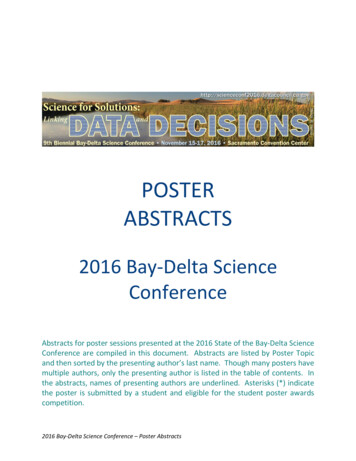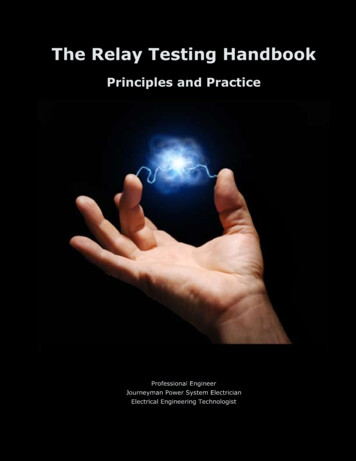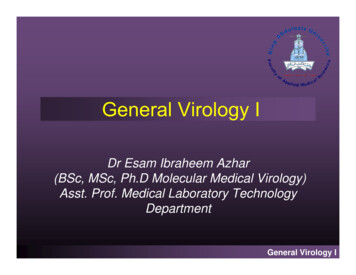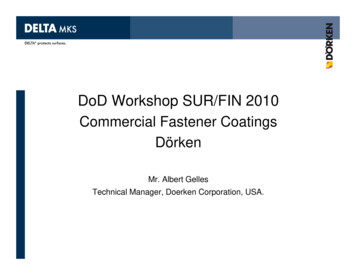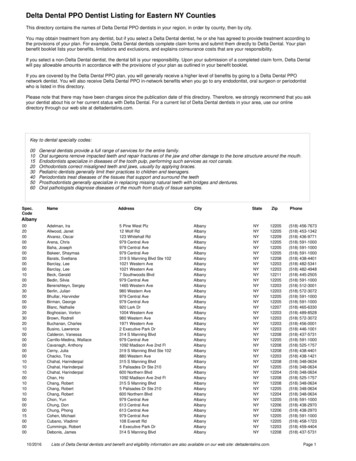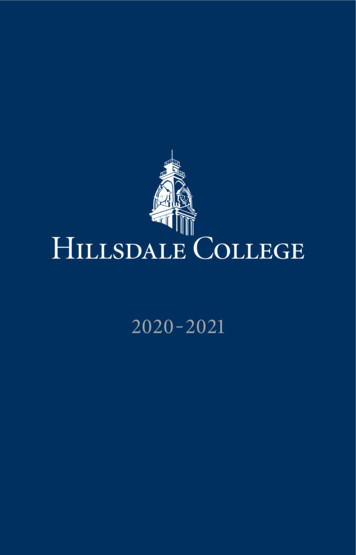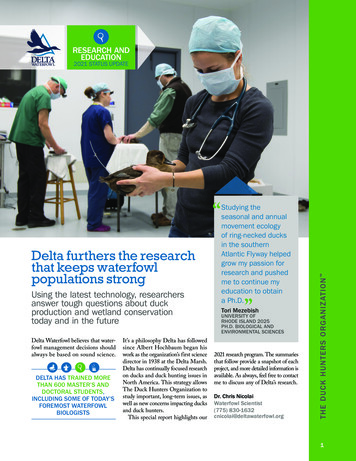
Transcription
RESEARCH ANDEDUCATION“Delta furthers the researchthat keeps waterfowlpopulations strongUsing the latest technology, researchersanswer tough questions about duckproduction and wetland conservationtoday and in the futureDelta Waterfowl believes that waterfowl management decisions shouldalways be based on sound science.DELTA HAS TRAINED MORETHAN 600 MASTER’S ANDDOCTORAL STUDENTS,INCLUDING SOME OF TODAY’SFOREMOST WATERFOWLBIOLOGISTSIt’s a philosophy Delta has followedsince Albert Hochbaum began hiswork as the organization’s first sciencedirector in 1938 at the Delta Marsh.Delta has continually focused researchon ducks and duck hunting issues inNorth America. This strategy allowsThe Duck Hunters Organization tostudy important, long-term issues, aswell as new concerns impacting ducksand duck hunters.This special report highlights ourStudying theseasonal and annualmovement ecologyof ring-necked ducksin the southernAtlantic Flyway helpedgrow my passion forresearch and pushedme to continue myeducation to obtaina Ph.D.”Tori MezebishUNIVERSITY OFRHODE ISLAND 2025PH.D. BIOLOGICAL ANDENVIRONMENTAL SCIENCES2021 research program. The summariesthat follow provide a snapshot of eachproject, and more detailed information isavailable. As always, feel free to contactme to discuss any of Delta’s research.Dr. Chris NicolaiWaterfowl Scientist(775) 830-1632cnicolai@deltawaterfowl.orgTHE DUCK HUNTERS ORGANIZ ATION 2021 STATUS UPDATE1
Canvasback Nest SuccessEvaluating Predator Managementfor over-water nesting ducksTRENT ROHRER, M.S. STUDENT,AND DR. JOSH STAFFORD,SOUTH DAKOTA STATE UNIVERSITYTHE DUCK HUNTERS ORGANIZ ATION Delta continues to seek effective andefficient application of Predator Management techniques to improve nestsuccess for over-water nesting duckssuch as canvasbacks, redheads andring-necked ducks in the parklandhabitat of Canada.Rohrer has spent the past two yearsexploring whether trapping in the fall,in addition to the spring, is a moreeffective way to reduce key mammaliannest predators, especially raccoons.We discovered fall trapping did littleto improve our take of raccoons –public enemy No. 1 of canvasbacks.However, our spring trapping in 2020showed some very positive signs,so we intensified that effort for thesecond field season. That includestrapping out in wetland edges whereour satellite tracking of coons showedthese introduced predators spend aninordinate amount of their time. Wewill be counting broods using dronesequipped with thermal and visual2cameras, since this approach has provenfar superior to field assistants doingground counts. Rohrer will be finishinghis M.S. work this year.Hot Spot Trapping toImprove Dabbler ProductionEvaluating dabbler nest successwith a new trapping techniqueMATT DAVIS, M.S. STUDENT, ANDDR. CHRISTOPHER MALCOM,BRANDON UNIVERSITYDelta is exploring whether focusingPredator Management on highly productive patches of grassland habitatscould more efficiently boost production of dabblers such as mallards,pintails and gadwalls. This projectis vastly different from past nesting/predator removal projects in that weare interested in assessing how manyducks are attempting to nest, ratherthan simply measuring nest success.Predator trapping has typicallyfocused on the full area of a township-sized block. Recent Delta researchprojects have identified “hot spot”trapping as a potentially more effectiveapproach to removing predators anda more efficient use of managementdollars. Focusing trapping efforts on“hot spots” (i.e., grass-only sites) wouldallow waterfowl managers neededflexibility in both the size and location of Predator Management sites.This project will take place in NorthDakota and help inform whether “hotspot” trapping can help increase duckproduction in the best quality habitats.To estimate how many ducks areusing the different treatment blocks,we are using a variety of methods toestimate how many nests are missedusing a single pass chain drag. Effortsto use GPS to map ATV tracks andnests will allow the use of distancesampling methods. We are alsodragging a sample of nesting covera second time within 20 minutes todetermine how many nests are missedon a single pass.Raccoon Satellite TelemetryStudying movements and habitat useof raccoons to improve effectivenessof Predator ManagementDR. CHARLOTTE MILLING,POST-DOCTORAL RESEARCHER,DR. STANLEY GEHRT ANDMR. SHANE MCKENZIE, MAXMCGRAW WILDLIFE FOUNDATIONIn 2018 and 2019, we fitted 29 raccoons with GPS transmitting collarson Delta’s canvasback study block inManitoba. The transmitters collectedincredible amounts of location data oneach raccoon’s daily movements. Wediscovered that raccoons spent a largepercentage of time in wetland edges.Due to Covid-19, we were unable totrack any raccoons in 2020. However,we are planning to collar 15 raccoonsto track their movements in breedingduck habitat. The goal is to betterunderstand raccoon habits so we canset traps in their preferred locations,thereby more effectively reducing thesetop predators of diving-duck nests.We will also use stable isotopes toevaluate the role of duck eggs in thediet of raccoons. Ultimately, the goalis to learn more about raccoons so wecan manage these non-native predatorsand increase production of canvasbacks,redheads, ring-necked ducks and otherover-water nesting ducks.
“This experience hasgreatly helped mycareer. I’ve had theopportunity to meetmany researchers,hunters, and landownersand share with them whywe’re doing this research.After graduation, I’ll bestarting a position asa research scientist,due in large part to theexperience I gaineddoing research for mymaster’s degree withDelta Waterfowl.Catrina Terry”THE DUCK HUNTERS ORGANIZ ATION LOUISIANA STATE UNIVERSITY 2021MASTER OF SCIENCE3
harvest — the only diver consistentlyin the top 10 in all four flyways.Ringnecks are doing well, and wehope to understand why they havebeen so successful at increasing innumbers. In addition, this researchhas immediate value to waterfowlmanagers in the Atlantic Flyway underthe recently implemented multi-stockharvest regulation-setting method.Importantly, our study suggests thatring-necked ducks that winter in thesoutheast are not nesting in the easternsurvey area, but farther west.Eastern Mallardbanding and isotopesUsing isotopes to determine whethermallards are moving between theUS and Canada during bandingoperationsKAYLA HARVEY, M.S. STUDENT,AND DR. MIKE SCHUMMER, STATEUNIVERSITY OF NEW YORK COLLEGEOF ENVIRONMENTAL SCIENCE ANDFORESTRYCounting BroodsUsing DronesEvaluating brood use of wetlands inagricultural landscapesTHE DUCK HUNTERS ORGANIZ ATION CATRINA TERRY, M.S. STUDENT, ANDDR. KEVIN RINGELMAN, LOUISIANASTATE UNIVERSITY4In 2019, we surveyed 242 PPR wetlands using a combination of camera-equipped drones and wetlandsampling and found 240 broods. In2020, 92 wetlands were sampled tofind 88 broods.Using a special drone equippedwith a thermal-imaging camera anda regular camera, researchers surveyselected wetlands in agricultural landscapes for brood use. The goal is tobetter understand brood use in orderto conserve the most important habitatfor breeding ducks. This research willevaluate the quality of wetlands as broodwater by examining usage by ducks,as well as determining invertebrateabundance, vegetation structure andinsecticide concentration.Terry has finished this field workand expects to complete her M.S.this year.Ring-necked Duck TrackingImplanting satellite transmitters tomonitor movements and habitat useDR. MITCH WEEGMAN,UNIVERSITY OF MISSOURIAfter three successful field seasonsmarking ring-necked ducks in 2018,2019 and 2020, Delta implanted anadditional 31 ringnecks with satellitetransmitters in Maryland during thefourth and final field season of theproject in February 2021.The goals are to monitor migrationpaths, discover breeding areas, andunderstand habitat use and movementsDELTA WATERFOWL’SRESEARCH AND EDUCATIONPROGRAM HAS RESULTEDIN MORE THAN 950 PEERREVIEWED STUDIESduring the ringneck’s annual cycle. Littleis known about ring-necked ducks,which is surprising because they are themost important diving duck in hunterMallards in the Atlantic flyway havedeclined by 40 percent in recent years,and reasons for this decline are not wellunderstood. Banding data, specificallypre-hunting season banding, is animportant tool used to monitor mallard and other waterfowl populations.Production and survival estimates forAtlantic flyway mallards, informedby banding data, have not changedsignificantly during the decline, suggesting a possible bias in these data.An important assumption used forthese estimates is that birds do not movebetween survey units. Recent researchsuggests the potential for migration ofmallards during the banding period.This project aims to use stable isotopeanalysis to determine whether mallardsare moving during the banding period. Feather samples from pre-seasonbanded birds throughout the Atlanticflyway will be collected for analysisof the deuterium isotope to obtaingeneral molt or natal origins. Thesewill then be compared to bandinglocations to assess movement duringthe banding period.
Michael Johnson,”COLORADO STATE UNIVERSITY 2023PH.D., FISHERIES, WILDLIFE AND CONSERVATION BIOLOGYTHE DUCK HUNTERS ORGANIZ ATION “While working as a Delta researcher, I have been able toconnect and network with a wide variety of people in thehunting, research, and agricultural communities. I learnedthat conservation issues are complex and challenging,nothing happens overnight, and working hard to connectwith people helps to build the necessary relationships thatpush conservation forward.5
Lower MississippiFlyway Dabbler TrackingDetermining duck locations duringhunting seasons and migrationTHE DUCK HUNTERS ORGANIZ ATION DANIEL ODIN, M.S. STUDENT,STARLA PHELPS, M.S. STUDENT, DR.DOUGLAS OSBORNE, UNIVERSITYOF ARKANSAS DIVISION OFAGRICULTURE, AND DR. MITCHWEEGMAN, UNIVERSITY OFMISSOURI6Delta Waterfowl seeks to better understand the migration and winteringground habits of dabbling ducks inthe Mississippi Flyway to determinewhether further management strategiesare needed.Employing backpack transmitterspowered by miniature solar panels,Delta installed radios on mallards,green-winged teal and American wigeonto record movements for the past twoyears. Ducks were caught during orafter the 2019-2020 and 2020-2021hunting seasons in Arkansas.The primary goal is to understandwhen and where these ducks migrate,particularly in the fall, as well as howthey respond to hunting pressure andweather events. Odin is focusing ondescribing preferred habitats eachspecies choose to use during thewinter. Phelps is assessing fine-scalemovements of these radios duringtheir time spent in the MississippiAlluvial Valley.Working WetlandsUnderstanding farmers’ perceptionsof Delta’s Working Wetlands programDR. CHERYL WACHENHEIM,NORTH DAKOTA STATE UNIVERSITYDelta Waterfowl, in partnership withthe U.S. Department of Agriculture Natural Resources ConservationService, initiated a new approach toconserving small wetlands in cropland. This research involves humandimensions survey work of programparticipants so that we can learn fromproducers and thereby determine howwe can better serve farm operations andprotect small wetlands that are criticalfor breeding ducks. The research willinform large, landscape-scale programdevelopment pioneered by Delta’sWorking Wetlands and incorporatedin the 2018 Farm Bill, in hopes ofconserving wetlands across the U.S.Prairie Pothole Region.Pintail Harvest and SurvivalHow does hunting harvest impactduck populations?THOMAS RIECKE, POST-DOCTORALRESEARCHER, UNIVERSITY OFNEVADA RENOResearchers are undertaking oneof the big unanswered questionsin waterfowl management: Whatinfluence does hunting harvest haveon populations?By using new scientific approaches,the team can more accurately answerthis question for a number of importantspecies, including mallards, pintailsand blue-winged teal. They will take aunique approach and look at populationcohorts (male/female and juvenile/adult) to more fully understand howdiffering survival rates might help inform the relationship between harvestand population sizes. In addition, theywill revisit our understanding of howdensity dependence (i.e., how manybreeding pairs of ducks that a givenyear’s wetlands can accommodate)works in duck populations. They arefinding that long-used models maynot improve our understanding ofthe impacts of hunter harvest on duckpopulations.Spatiotemporal Variationin Duck Demographic RatesHow environmental changeinfluences duck population dynamicsMADELEINE LOHMAN, PH.D.STUDENT, AND DR. PERRYWILLIAMS, UNIVERSITY OF NEVADARENOWaterfowl monitoring efforts have created one of the few extensive multi-species, longitudinal, individual-based datasets in the world. Using these data,
Has PintailProduction Declined?Evaluating changes in pintail agestructure and sex ratiosDR. TODD ARNOLD, UNIVERSITY OFMINNESOTAPintail population trends are of greatinterest to duck hunters, especially inlight of U.S. Fish and Wildlife Serviceregulations lowering the bag limit toone bird per day in 2017-2018, andagain for the 2019-2020 and 2020-2021seasons. Dr. Arnold is reviewing pintailage and sex ratios using USFWS PartsCollection Survey data to documenthow age ratios (proportion of juvenilesin the fall flight) and sex ratios (femalesto males) have changed since 1961. Thiswork is important to inform the pintailharvest models used to set regulations.Additionally, examining long-termpintail data has become more important, as data sets continue to grow andanalytical techniques expand to makesense of long-term changes.Atlantic FlywayMallard Stable IsotopeDetermining the origins of mallardstaken by hunters in the eastSAM KUCIA, M.S. STUDENT ANDDR. MIKE SCHUMMER, STATEUNIVERSITY OF NEW YORK COLLEGEOF ENVIRONMENTAL SCIENCE ANDFORESTRYDelta is undertaking this importantresearch to inform mallard harvestregulations in the Atlantic Flyway.Spring surveys suggest that theeastern U.S. mallard population isdeclining, while eastern Canada’smallards are holding stable. Thereforewe need to understand the relativeimportance of the different breedingareas, particularly given the reductionof Atlantic Flyway mallard limits totwo mallards (one hen) daily for the2019-2020 and 2020-2021 seasons.By examining stable isotopes inthe flight feathers of mallards shotin the Atlantic Flyway, researcherscan determine where the ducks grewthose feathers in the summer. This isa novel way to determine the originsof birds shot in the Atlantic Flyway.Banding data currently estimates thatabout two-thirds of mallards shot inthe eastern U.S. stem from the easternU.S. breeding population. We arefinding that the banding data doesnot account for movement of birdsfrom Canada prior to the bandingperiod and that a larger proportionthan expected of Canada derivedbirds are being banded in the U.S.Eastern mallard ecology and harvestmanagement have taken a back seatrelative to other flyways, but we aimto reverse this information deficit anddeliver quality information that canhelp better manage eastern mallards.Kucia is completing his analysesand writing his thesis and plans tograduate this year.Canvasback/RedheadIntegrated Population ModelsDetermining needs for managementof key diver speciesDR. DAN GIBSON, POST-DOCTORALRESEARCHER AND DR. DAVIDKOONS, COLORADO STATEUNIVERSITYRedheads and canvasbacks use thesame breeding habitat in the PPR(primarily Manitoba and Saskatchewan),and Delta has collected extensive dataon pairs, nests and broods for bothspecies. By using multiple data setssimultaneously, we can learn moreTHE DUCK HUNTERS ORGANIZ ATION Lohman will investigate spatiotemporal variation in demographic ratesof dabbling ducks in the PPR to helpshed new light on basic biology andconservation needs of widely distributedwildlife populations.This work will focus on variation inmallard demographic rates, correlationsbetween mallard survival and ageratios, and spatiotemporal variationin natural and harvest mortality. Wewill then use these methods to comparemulti-species demographic rates.7
about what drives their populations.The goal of this data analysis workis to develop a model of the annual lifecycles for canvasbacks and redheadsto determine what factors drive theirpopulation growth. The resultingmodels will characterize the importanceof nest success, survival of nestinghens, brood survival, winter survivaland hunting mortality on populationgrowth of redheads and canvasbacks.The results from this study will benefitmanagement efforts and help drivefuture research efforts on these species.Canvasback Habitat ModelingAnalyzing nest success in relation tohabitat variablesTHE DUCK HUNTERS ORGANIZ ATION MICHAEL JOHNSON, PH.D.CANDIDATE AND DR. DAVID KOONS,COLORADO STATE UNIVERSITY8After several seasons of extensivefield work on nesting canvasbacks inManitoba, Johnson will analyze habitatvariables to determine their impact onnest abundance, nest success, and broodcounts. The goal is to determine thebest locations on the prairie breedinggrounds for canvasback production.This information will help waterfowlmanagers target where to best investin wetland conservation programs tobenefit canvasback production.Mercury Loading inNevada Wood DucksDemographics of a wood duckpopulation in a mercury superfund siteMORGAN BYRNE, M.S. STUDENT, DR.PERRY WILLIAMS, DR. MAE GUSTIN,UNIVERSITY OF NEVADA RENO,AND DR. CHRIS NICOLAI, DELTAWATERFOWLDelta’s Dr. Chris Nicolai has maintained an 18-year project monitoringan isolated population of wood ducksin western Nevada. During the life ofthis project, feather samples have beencollected from all banded birds andrepeated feather sampling occurredfor all nesting hens. Byrne collectedliver, breast tissue and two types offeather samples from 100 hunter-killeddata to gain understanding of thetrade-offs these ducks are making tomaintain a stable population.Large Scale PacificFlyway Radio ProjectMonitoring movements of geese andducks in the Pacific FlywayDELTA WATERFOWL’S LEGACYOF LEADING-EDGE SCIENCEDATES TO THE 1930S, WHENALDO LEOPOLD VISITEDMANITOBA’S DELTA MARSH.wood ducks. Importantly, she foundmercury levels as high as 40,000 ppband found a correlation between tissueand feather samples. She will comparemother and offspring levels of mercuryto determine whether offspring directly,or indirectly inherit mercury loadings.The levels of mercury found in thispopulation of wood ducks is among thehighest levels ever recorded in a birdspecies, exceeding levels for survivaland reproduction. We will use thisDR. CHRIS NICOLAI, DELTAWATERFOWL, MIKE CASAZZA, USGS,CLIFF FELDHEIM, CA DEPARTMENTOF WATER RESOURCES, MARKPETRIE, DUCKS UNLIMITED, ANDCAROLINE BRADY, CALIFORNIAWATERFOWL ASSOCIATIONThis is the largest scale satellite telemetryproject ever undertaken, having markedmore than 800 ducks and geese of 14 species in the past six years. To do so requiresnumerous partners to assist with fittingbirds with radios, maintaining massive datasets, and analyzing and writing papers.The three primary objectives are to assessthe full annual cycle of habitat use; howdifferent populations of the same speciesare delineated; and how overpopulationsof some geese impact the limited foodresources of ducks.Research LeadersThroughout the organization’s storied history, Delta Waterfowl hasamassed an impressive body of research that includes supportingmore than 300 graduate students and publishing more than 950 peerreviewed scientific papers.Delta’s research has profoundly influenced how waterfowl, wetlands andannual harvest are managed. It has also provided biologists, techniciansand young scientists with the opportunity to gain hands-on experienceand guidance to become leaders in waterfowl and wetland conservation. We are proud that many of Delta’s former students are workingfor government and non-government agencies, as well as universities.Delta Waterfowl’s important waterfowl and wetland research is madepossible by you — our generous donors, members and volunteers. Wedeeply appreciate your support. Thank you!DELTAWATERFOWL.ORGU.S. Office1412 Basin AvenueBismarck, ND 58504OFFICE 701.222.8857TOLL FREE 1.888.987.3695usa@deltawaterfowl.orgCanada Office200-1765 Sargent AvenueWinnipeg, MB R3H 0C6OFFICE 204.956.7766TOLL FREE 1.877.667.5656canada@deltawaterfowl.org
fourth and final field season of the project in February 2021. The goals are to monitor migration paths, discover breeding areas, and understand habitat use and movements during the ringneck’s annual cycle. Little is known about ring-necked ducks, which is surprising


